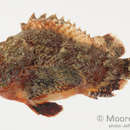Diagnostic Description
provided by Fishbase
Submarginal black band on inner pectoral fin surface complete; eyes relatively large; snout relatively short; hump on back less obvious as in S. diabolus; SL to 10.4 cm. No black spot nearly as large as eye on inner surface of pectoral fins. A narrow triangular black mark inside mouth at front of upper jaw behind teeth. Ascending process of premaxilla broad, its maximum width 1.4-1.8 in orbit diameter. No series papillae or nodules across interorbital space between supraocular spines. Nasal spine single (Ref 42181).Description: Characterized by having variable colors, depends on surrounding substrate; inner pectoral fin bright orange with small black spot at base and black submarginal band; double upper opercular spine; snout 3.1-3.4 in head length; depth of body 2.2-2.7 in SL (Ref. 90102).
Morphology
provided by Fishbase
Dorsal spines (total): 12; Dorsal soft rays (total): 9; Analspines: 3; Analsoft rays: 5
Trophic Strategy
provided by Fishbase
Occurs in inshore waters of the continental shelf. Often trawled (Ref. 75154).
- Recorder
- Auda Kareen Ortañez
Biology
provided by Fishbase
A rare inhabitant of mixed sand and rubble areas of reef flats and shallow lagoons. Feeds on fishes (Ref. 89972). Usually buries itself in the substrate when in sand or sits amongst rubble where it has good camouflage (Ref. 48635). Anterolateral glandular grooves with venom gland (Ref. 57406). Solitary or in pairs (Ref 90102).
- Recorder
- Estelita Emily Capuli

